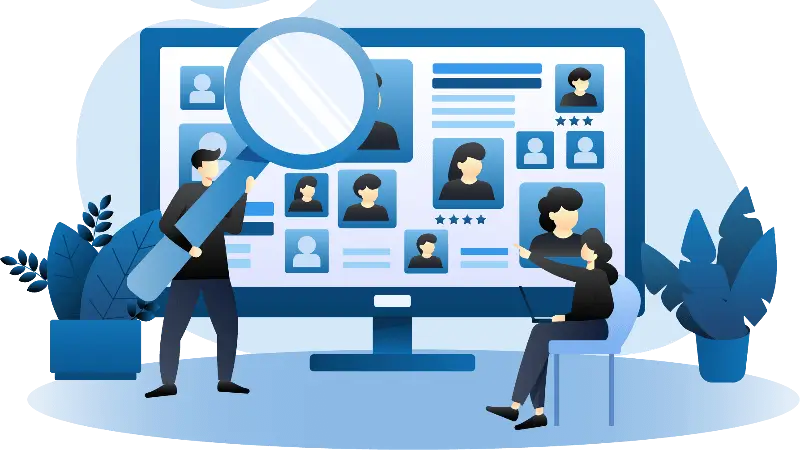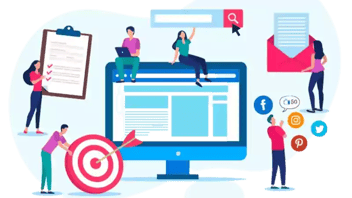The Buyer's Journey: A Guide for B2B Marketers
Even if you work in sales or marketing, you're likely being sold or marketed to more often than selling to others. Whether it's targeted advertising on your most-frequented websites or in-person sales pitches at your local stores, you're almost constantly being asked to consider a panoply of different products and services.
Let's imagine that in the middle of an in-person sales pitch, the salesperson starts referring to you as a "lead." She asks you what steps they can take to "convert" you and "close the deal." Just a guess, but it's hard to imagine you'll want to buy from this business. Why? Because they're talking about the sale in terms of the business's needs rather than yours. In other words, they're failing to consider the Buyer's Journey.
Why Does the Buyer's Journey Matter?
-
72% of B2B buyers say they're likelier to do business with a company that provides relevant content. To win over B2B buyers, businesses must provide relevant and engaging content in various formats, such as blog posts, white papers, infographics, and webinars. This content should be informative and valuable, catering to the needs and interests of the target audience.
-
80% of B2B buyers use social media to research potential vendors. To win over B2B buyers, businesses must establish a robust social media presence. They must create and distribute relevant content, actively engage with potential customers, and proactively respond to comments and inquiries.
-
67% of B2B buyers want to be contacted by a sales representative after they've expressed interest in a product or service. To win over potential customers, businesses must have a streamlined sales process that efficiently identifies and contacts those ready to purchase. Quick action and prompt communication are key to converting leads into sales.
-
The average B2B buyer spends 17 hours researching a purchase. B2B marketers must understand that buying is a journey, not a quick transaction. Patience and persistence are key to keeping potential customers engaged throughout the process, providing them with the necessary information to make an informed decision. By doing so, businesses can establish trust and build relationships with their target audience, increasing the likelihood of a successful conversion.
-
The average B2B buyer engages with 12 different vendors before making a purchase. To win over potential customers, businesses must stand out from the competition with a unique and compelling value proposition. They should strive to differentiate themselves meaningfully and offer something that their rivals cannot match to appeal to potential customers.
Buyer's Journey vs. Sales Funnel
So what, exactly, is the Buyer's Journey? Simply put, the entire sales and marketing process is reimagined from the buyer's perspective. Rather than moving from a lead to a conversion, the buyer begins by identifying a need or issue, researching the issue to ascertain whether anyone is selling a viable solution, and then making a decision based on his or her needs.
The buyer's journey in B2B marketing is the process that a potential customer goes through to become aware of, evaluate, and decide to purchase a product or service from a business. As stated by HubSpot, "buyers don't wake up and decide to buy on a whim. They go through a process to become aware of, consider and evaluate, and decide to purchase a new product or service."
By inverting the traditional sales train-of-thought in this way, businesses can more effectively tailor their messaging, marketing campaigns, and content creation to each buyer's process before coming to a decision. By looking at this process through the eyes of your prospective buyers, you can more easily empathize with their position and provide them with the advice and information they need.
Compare this to a more traditional sales funnel. Because there is no structure for thinking through the process from the buyer's perspective, it can be difficult to figure out precisely what information or content would be helpful to prospects at different stages of that process. As a result, many businesses overwhelm their potential customers with product specifications and hard sales pitches before they've even figured out the nature of the problem they're trying to solve.
The Stages of the Buyer's Journey
Generally, there are three stages of the buyer's journey. Thinking about the journey in terms of these stages can help you understand your potential customers' changing needs as they move deeper into the sales process.
Awareness stage
At the awareness stage, your prospective buyer realizes he or she has a need or problem. They might not have a name for it, and they might not be sure that it's something that they'll need to take steps to resolve. During the awareness stage, buyers might search for educational content that helps them define their issues clearly and point them toward possible solutions. Presenting awareness-stage buyers with a litany of reasons why your product will solve their problem won't be an effective tactic because they don't know their problem yet.
During the Awareness stage, buyers are often motivated by a desire for personal growth or advancement. Individuals may be trying to make more money, save more money, or find more success with their business or personal life. Understanding these motivations can help businesses create content that resonates with their target audience.
Consideration stage
Consideration-stage buyers have defined their problems and are ready to research possible solutions. They may not be ready to think about individual products or services, but they're eager to know what types of products and services might be available in the marketplace to help them address the needs they've uncovered. Critically, they still haven't decided to buy anything (they might realize that they already have the resources to solve their problem or that it isn't worth the money it might take to deal with it directly). They're open to purchasing but still gathering the information they'll need to make an informed decision. Here, your content and messaging should show them a potential solution and how to evaluate it.
During this stage, a buyer might be:
Researching potential solutions: Searching for information online, reading reviews, and comparing products or services that could solve their problem or fulfill their need.
Requesting more information: Contact the businesses they are considering and request more detailed information about their products or services. This could involve asking for a demo or speaking with a sales representative.
Evaluating different options: Creating a list of pros and cons for each option they are considering or creating a comparison chart to evaluate the solutions they have found.
Decision Making stage
Finally, we come to the last stage. The prospective buyer has finished researching and is ready to make a decision. This is where your potential customers will be ready to think about and evaluate specific products—including yours! This is when your buyers are ready for a more traditional sales pitch that differentiates your product from similar options. Though this is the first instance in which it's really helpful for a buyer to hear about the specifics of your offerings, remember to continue to couch your discussion regarding their needs.
So What?
Okay, we've danced around the answer to this question in the sections above, but let's get a little more explicit: what does this have to do with marketing in general and B2B marketing in particular?
The Buyer's Journey helps you segment your audience into categories based on their changing needs.
You move from "always be closing" to "always be helping."
In a traditional sales funnel, everyone is assumed to be eager to hear increasing information about your company or product; in the Buyer's Journey, you put your product aside to help educate the consumer until the final stage. Why? Because that's how people make informed decisions—an informed customer is an ideal customer.
This is especially true in B2B, where businesses may purchase enterprise software requiring ongoing support and information or large, expensive bulk purchases that need to be just right. If, for instance, you're providing software to other businesses, you'll want to organize your leads based on where they are in their respective journeys. Suppose you're developing an e-mail marketing campaign. In that case, you can ensure that your awareness-stage prospects receive relevant content that helps them define their problem with their hiring, marketing, automation, etc.
Likewise, buyers would receive emails at the consideration stage that help them understand the problem and explore solutions. Only once they've reached the decision stage would you try to schedule a call to discuss your product and how it might resolve their problems. In this way, you guide your prospective buyers through their decision-making process rather than trying to push them through it. More often than not, they'll thank you by giving you their business.
Buyer's Journey FAQs
The buyer's journey is the process a potential customer goes through as they become aware of, evaluate, and decide to purchase a product or service. It is often divided into three stages: awareness, consideration, and decision.
The stages of the buyer's journey in B2B marketing are similar to those in the consumer buyer's journey, but they may be more complex. The three stages are:
- Awareness: The buyer becomes aware of their problem or need.
- Consideration: The buyer evaluates different solutions to their problem.
- Decision: The buyer makes a decision to purchase a solution.
To map the buyer's journey for your B2B marketing, you need to understand your target audience's needs and pain points. Once you understand their needs, you can map out the steps they take as they become aware of, evaluate, and decide to purchase a solution.
Here are some best practices for B2B marketing at each stage of the buyer's journey:
- Awareness: Create content that educates your target audience about their problem or need.
- Consideration: Provide content that helps your target audience evaluate different solutions.
- Decision: Make it easy for your target audience to make a decision by providing clear pricing information and a call to action.
There are several ways to measure the effectiveness of your B2B marketing at each stage of the buyer's journey. Some standard metrics include:
- Awareness: Website traffic, social media engagement, and lead generation.
- Consideration: Website conversions, whitepaper downloads, and webinar registrations.
- Decision: Sales revenue, customer lifetime value, and customer satisfaction.
The buyer's journey can be a valuable tool for improving your B2B sales process. By understanding the stages of the buyer's journey, you can identify the right time to reach out to potential customers and provide them with the information they need to make a decision.
There are many benefits to understanding the buyer's journey, including:
- Improved marketing and sales alignment: By understanding the buyer's journey, you can ensure that your marketing and sales teams are aligned and working together to reach your target audience at the right time. This can lead to increased lead generation and sales.
- Increased lead generation: By understanding the buyer's journey, you can create content and experiences that are tailored to each stage of the journey. This can help you attract more qualified leads and convert them into customers.
- Improved customer satisfaction: By understanding the buyer's journey, you can provide your customers with the information and support they need at each stage. This can lead to increased customer satisfaction and loyalty.
- Reduced marketing costs: By understanding the buyer's journey, you can make more informed decisions about where to allocate your marketing budget. This can help you save money and get a better return on your investment.
This content is also available in:
- German: Buyer's Journey im Inbound Marketing: Leitfaden für B2B-Vermarkter
- Spanish: El Buyer Journey: Guía para profesionales del marketing B2B
- French: Le parcours de l'acheteur : Un guide pour vos marketing B2B
- Italian: Il viaggio dell'acquirente: Una guida per i marketer B2B
- Romanian: Buyer's journey B2B: succesul în marketing și vânzări
- Chinese: 买家之旅:B2B 营销人员指南










Leave a Comment